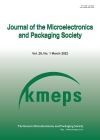A Study on the Electrical Characteristics of Different Wire Materials
- 한국마이크로전자및패키징학회
- 마이크로전자 및 패키징학회지
- 제20권 제4호
-
2013.1247 - 52 (6 pages)
-
DOI : 10.6117/kmeps.2013.20.4.047
- 3

Gold wire has long been used as a proven method of connecting a silicon die to a substrate in wide variety of package types, delivering high yield and productivity. However, with the high price of gold, the semiconductor packaging industry has been implementing an alternate wire material. These materials may include silver (Ag) or copper (Cu) alloys as an alternative to save material cost and maintain electrical performance. This paper will analyze and compare the electrical characteristics of several wire types. For the study, typical 0.6 mil, 0.8 mil and 1.0 mil diameter wires were selected from various alloy types (2N gold, Palladium (Pd) coated/doped copper, 88% and 96% silver) as well as respective pure metallic wires for comparison. Each wire model was validated by comparing it to electromagnetic simulation results and measurement data. Measurements from the implemented test boards were done using a vector network analyzer (VNA) and probe station setup. The test board layout consisted of three parts: 1. Analysis of the diameter, length and material characteristic of each wire; 2. Comparison between a microstrip line and the wire to microstrip line transition; and 3. Analysis of the wire's cross-talk. These areas will be discussed in detail along with all the extracted results from each type the wire.
1. Introduction
2. Modeling and Simulation
3. Measurement Results
4. Conclusions
References
(0)
(0)